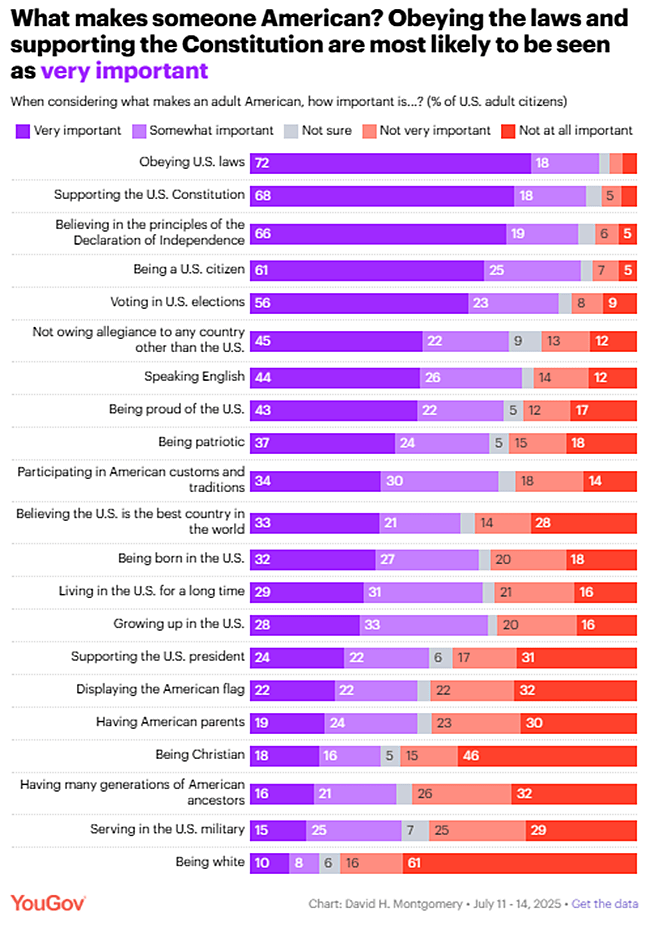In 2025, President Trump’s Department of Homeland Security (DHS) attempted and carried out so many unlawful, unconstitutional, immoral, and economically and socially damaging actions in the name of “immigration enforcement” that it is difficult to rank them. Nonetheless, it is worth considering which DHS actions were the most impactful.
- Banning legal immigrants: As I predicted, President Trump’s administration has already lowered legal entries far more than illegal entries simply by canceling the CBP One port of entry scheduling app for asylum seekers at the southwest border and the humanitarian parole sponsorship processes. He has effectively ended the refugee program, slashing permanent legal immigration by about 10 percent. As I reported, he has now also banned legal immigration for about 20 percent of legal immigrants. His administration suspended the immigrant visa lottery without warning in December, and it unilaterally imposed a $100,000 fee on companies seeking to hire H‑1B workers. All these actions will lead to the largest restriction in legal immigration—setting aside 2020—since the 1920s, and will cause the first sustained reduction in the total immigrant population in decades.
- Cancellation of legal statuses: The most important immigration story in 2025 was the mass cancellation of lawful status for the roughly 2.5 million immigrants with humanitarian parole and Temporary Protected Status (TPS). In justifying these actions, DHS cited risible claims like Afghanistan becoming a tourist destination, Haiti being a safe country, and vetted Venezuelans with legal status and no criminal record being a serious threat to Americans. In its haste to cancel the parole grants, DHS accidentally sent notices telling US citizen attorneys to leave the country.
These decisions manufactured millions of illegal immigrants who would be easy to identify and deport. As I documented, DHS deported dozens of legal immigrants straight to a Salvadoran torture prison. The president’s attempt to end birthright citizenship would force actual US citizens to leave, and although courts have blocked it for now, his executive order demonstrates how little this deportation campaign cares about “illegality” as opposed to body counts.
- Deprioritization of criminals: Despite the administration’s relentless rhetorical focus on criminal immigrants, the administration has radically shifted its efforts away from public safety threats. As I’ve reported, by October, just 5 percent of ICE book-ins had violent criminal convictions. Nearly three-quarters had no conviction at all. The number of ICE arrests of people without charges or convictions has increased by 1,200 percent since the start of the year. This makes sense because they are arresting legal immigrants who were vetted before and during the time that they had status.
Moreover, as I’ve described, DHS has diverted much of the federal criminal law enforcement from their jobs, including a quarter of the FBI, half the DEA, two-thirds of the ATF, and almost 90 percent of Homeland Security Investigations. This has led to a drastic reduction in arrests for various kinds of trafficking, including child sex trafficking and weapons trafficking.
- “Papers-please” profiling: The effect of the Supreme Court’s decision in Perdomo v. Noem has been to green-light arrests, detentions, and harassment of people based on demographic characteristics like race, without any actual evidence that they are in the country illegally. As I documented, the Perdomo injunction had blocked about two-thirds of all arrests in the Los Angeles area where it was in effect.
Since the injunction was lifted, it has turbocharged the profiling operation in the rest of the country. From January 20 to October 15, more than 40,000 people were arrested off the streets who have never been charged with any crime and for whom DHS has no removal orders—in other words, people whom ICE had no reason to single out. The total is likely over 60,000 by now since, by the middle of October, DHS was already making 2,000 such arrests per week.
- Attacks on the Constitution: Papers-please policing is one of many assaults on the Constitution. DHS agents are routinely trespassing on private property to make immigration arrests, and DHS is leading the charge for the most extreme attack on the First Amendment this century. It is arresting and imprisoning people for political speech, even op-eds mildly critical of college administrators. As I’ve documented, DHS has labeled ICE observers who record them “domestic terrorists” and has launched a campaign of threats, arrests, and violence to stop them.
ICE has attempted and largely succeeded in stripping constitutionally protected due process from many immigrants being deported. The Supreme Court ruled 9–0 that using the Alien Enemies Act to spirit away hundreds of Venezuelans to an El Salvador prison in the dead of night was unconstitutional, but the administration has evaded accountability for that brazen act. Nonetheless, ICE continues to abuse “expedited removal” to arrest and deport people without a hearing, which is leading to tens of thousands of additional deportations every month.
The good news is that the Trump administration has not, in fact, deported “millions and millions” of people. The primary reason that the immigrant population is falling is not deportations or even self-deportations, but because of the dramatic drop in immigration—legal and illegal—to the United States. That development is unfortunate. Despite the hailstorm of attacks, however, immigrants continue to help Americans, reducing government deficits, innovating and starting businesses, growing the economy, increasing the availability of critical goods and services, and improving our lives in innumerable other ways.




